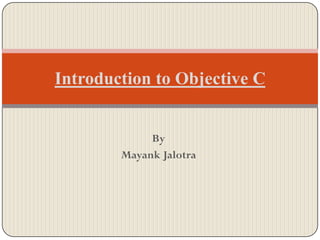
Introduction to objective c
- 1. Introduction to Objective C By Mayank Jalotra
- 2. INTRODUCTION Objective-C was invented by Brad Cox and Tom Love. Objective-C is a high-level, object-oriented programming language that adds Smalltalk-style messaging to the C programming language It is the main programming language used by Apple for the OS X and iOS operating systems and their respective APIs, Cocoa and Cocoa Touch Mayank Jalotra
- 3. INTRODUCTION (Cont.) Objective-C source files has a “.m” extension. “.h” file is the interface file. For example: ─ main.m ─ List.h (Interface of List class.) ─ List.m (Implementation of List class.) Mayank Jalotra
- 4. SYNTAX Objective-C is a thin layer on top of C, and moreover is a strict superset of C. It is possible to compile any C program with an Objective-C compiler. Objective-C derives its object syntax from Smalltalk. All of the syntax for non-object-oriented operations are identical to that of C Mayank Jalotra
- 5. Basic syntax structure C++ syntax : void function(int x, int y, char z); Object.function(x, y, z); Objective-C syntax : -(void) function:(int)x, (int)y, (char)z; [Object function:x, y, z]; Mayank Jalotra
- 6. Keyword: id The word „id‟ indicates an identifier for an object much like a pointer in c++. This uses dynamic typing. For example, if Pen is a class… extern id Pen; id myPen; myPen = [Pen new ]; Mayank Jalotra
- 7. MESSAGES To get an object to do something, you send it a message telling it to apply a method. In Objective-C, message expressions are enclosed in square brackets [receiver message]. In Objective-C one does not simply call a method; one sends a message Mayank Jalotra
- 8. Messages Cont. For example, this message tells the myRect object to perform its display method, which causes the rectangle to display itself [myRect display]; [myRect setOrigin:30.0:50.0]; Mayank Jalotra
- 9. HELLO WORLD Hello World Mayank Jalotra
- 10. CODE EXPLAINATION [1] CODE EXPLAINATION The parameter argc is the argument count at the time the program is invoked. For example, if your program was called “justarty” and you typed “justarty one two” into the command line the computer would execute justarty.exe after passing “one” and “two” into the program. The value stored in the program for argc would be 3 (including the program name). The parameter argv on the other hand is the actual array of arguments. In our example the array of arguments would be argv[0] = “justarty” argv[1] = “one” argv[2] = “two” Mayank Jalotra
- 11. CODE EXPLANATION [2] NSAutoreleasePool * pool = [[NSAutoreleasePool alloc] init]; • The NSAutoreleasePool is one of Cocoa's memory- management tools. NSLog(@"Hello, World!"); The NSLog function works very much like printf in the C language. The difference is that NSLog takes an NSString object instead of a C string. The @" . . . " construct is a compiler directive that creates an NSString object using the characters between the quotation marks. Mayank Jalotra
- 12. CODE EXPLANATION [3] [pool release]; • This line contains another part of Cocoa's memory housekeeping return 0; • A return from the main function indicating a normal program exit //NS stands for NeXTSTEP. All of the classes and functions in the Cocoa frameworks start with NS. Mayank Jalotra
- 13. Example 1: #import <Foundation/Foundation.h> int main(int argc, const char* argv[]) { NSAutoreleasePool* pool = [[NSAutoreleasePool alloc] init]; NSLog (@”Hello World”); int undergrads = 120; int postgrads = 50; int students = undergrads + postgrads; NSLog (@”Now featuring...n %i Computer Science students”, students); [pool drain]; return 0; } Mayank Jalotra
- 14. INTERFACE The declaration of a class interface begins with the compiler directive @interface and ends with the directive @end. @interface ClassName : ItsSuperclass { instance variable declarations } method declarations @end ─ Goes in source(.h) file Mayank Jalotra
- 15. IMPLEMENTATION The implementation of the class is done as : #import <Foundation/Foundation.h> #include “interfacename.h“ @implementation ClassName define method function here; define another method function here; define yet another method function here; @end ─ Goes in source(.m) file Mayank Jalotra
- 16. Example 2: ComputerScience.h Example 3: ComputerScience.h @interface ComputerScience : NSObject { int mUndergrads; int mPostgrads; } -(void) print; -(void) setUndergrads: (int) undergrads; -(void) setPostgrads: (int) postgrads; @end Mayank Jalotra
- 17. Example 2: ComputerScience.m #include “ComputerScience.h” @implementation ComputerScience -(void) print { int totalStudents = mUndergrads + mPostgrads; NSLog (@”Total students in CompSci= %i”, totalStudents); } -(void) setUndergrads: (int) undergrads { mUndergrads = undergrads; } -(void) setPostgrads: (int) postgrads { mPostgrads = postgrads; } @end Mayank Jalotra
- 18. Data Structures Objective-C arrays are similar to C arrays, but you can initialize whole array in a list. Or just a few indices of the array. The rest are set to 0. Or mix and match; the example will create an array of size [8]. int values[3] = { 3, 4, 2 }; char letters[3] = { 'a', 'c', 'x' }; float grades[100] = {10.0,11.2,1.1}; int array[] = {[3]=11,[2]=1,[7]=0}; Mayank Jalotra
- 19. Arrays and Functions Arrays can be passed as arguments to functions. This function will print every integer in an array but it needs to also be told how long the array is (arrayLength). Statements with hard-coded indices such as array[4] are potentially dangerous. void function(int array[], int arrayLength) { int fourthValue = array[4]; for (int i = 0; i < arrayLength; i++) { NSLog(@”%i”, array[i]; } } Mayank Jalotra
- 20. References Learning Cocoa with Objective-C By Apple Computer, Inc. , James Duncan Davidson Start Programming the Mac Using Objective-C By Bert Altenberg, Alex Clarke Objective-C for Absolute Beginners By Gary Bennett, Mitch Fisher, Brad Lees Various Authors. Wikipedia: the Free Encyclopedia http://en.wikipedia.org http://stackoverflow.com/questions Mayank Jalotra
